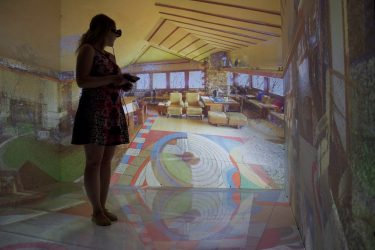Atop a hill in the sprawling countryside outside of Spring Green, WI, sits a rare architectural and artistic jewel. Taliesin was once the home of renowned Wisconsin-based architect Frank Lloyd Wright, and embodies his vision – from the rolling hills and bluffs of the Driftless Area to the “low, wide, and snug” interior, filled with distinctive furniture and art.
The iconic place has been visited by thousands, but its latest guests had an entirely unique experience. On August 26, a group of about 40 people gathered on the lower level of the Discovery Building for the first tours of Virtual Taliesin inside the CAVE, a fully immersive 3D environment at WID’s Living Environments Laboratory.

The lab uses 3D scanning and visualization technology to study home health environments through the vizHOME project but has also become a leader in the field of virtual reality in other areas, from crime scene analysis to data visualization and more. Earlier this summer, Taliesin became the newest addition to the lab’s catalog of scans. In partnership with the Frank Lloyd Wright Foundation and Taliesin Preservation, Inc., 80 LiDAR scans and numerous quad copter videos of the estate were transformed into a 3D Point Cloud for visualization in the CAVE.

The crowd at the showcase event was diverse, including virtual reality experts, historic preservation specialists, artists, and interested members of the public. “Some attendees came because they were interested in architecture, while others came to find out more about science or because they were interested in the technology,” says Professor Kevin Ponto, whose research advances the field of virtual reality across a broad range of applications. The night began with opening remarks from Dr. Patricia Flatley Brennan, the leader of the Living Environments Lab. Guests also heard from Dr. Ponto about the technology behind the display and from Ryan Hewson, the preservation project manager at Taliesin.
“Creating an engaging and educational experience for such diverse group is very rewarding for all involved”
-Kevin Ponto
Conversations throughout the evening focused on the use of technology for preservation of historical spaces, home health technologies, Wright architecture, and other applications of virtual reality. The 15-minute guided tours in the CAVE were memorable and enlightening, providing a new perspective even for those who had visited the real Taliesin many times. The marriage of technology, history, and art and architecture made for a singular experience.
“This was a unique event for us — creating an engaging and educational experience for such diverse group is very rewarding for all involved,” says Ponto. This fall, the Living Environments Lab will be taking Virtual Taliesin on the road, showcasing the scenario in several statewide outreach events and bringing an important piece of Wisconsin’s culture and history with them.

— Nolan Lendved


You must be logged in to post a comment.